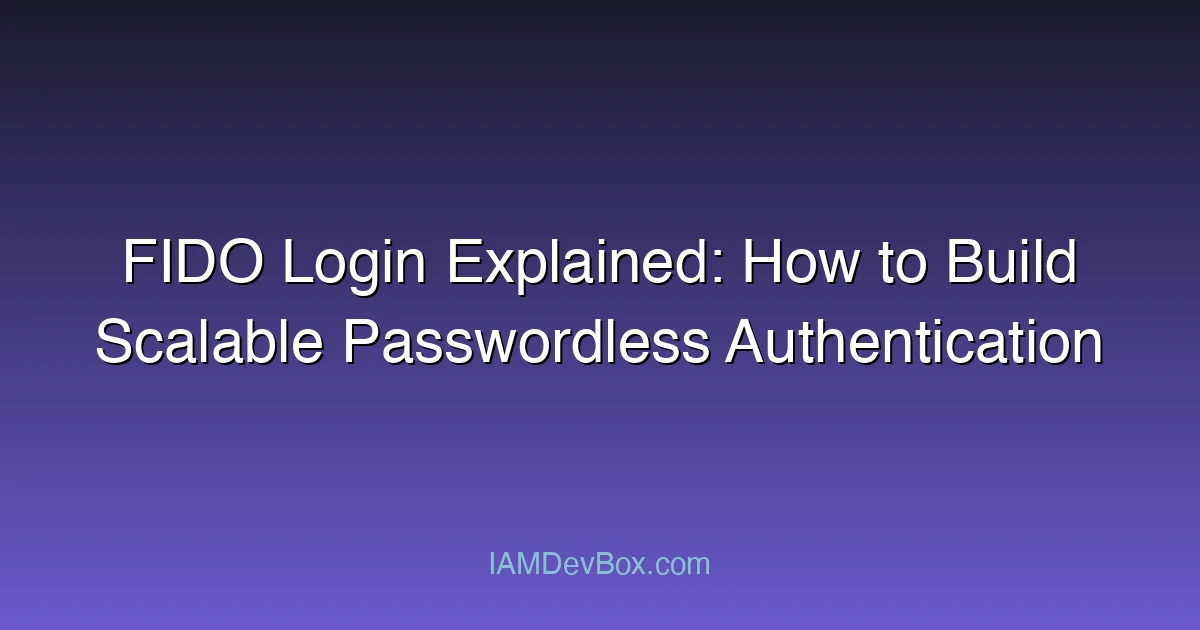Visual Overview:
graph TB
subgraph "Authentication Methods"
Auth[Authentication] --> Password[Password]
Auth --> MFA[Multi-Factor]
Auth --> Passwordless[Passwordless]
MFA --> TOTP[TOTP]
MFA --> SMS[SMS OTP]
MFA --> Push[Push Notification]
Passwordless --> FIDO2[FIDO2/WebAuthn]
Passwordless --> Biometric[Biometrics]
Passwordless --> Magic[Magic Link]
end
style Auth fill:#667eea,color:#fff
style MFA fill:#764ba2,color:#fff
style Passwordless fill:#4caf50,color:#fff
Introduction
Traditional login systems—relying on passwords and MFA tokens—are increasingly vulnerable to phishing, credential stuffing, and human error. In contrast, FIDO login offers a modern, passwordless alternative built on public key cryptography, ensuring a seamless yet secure user experience.
This blog post explores the technical implementation and benefits of FIDO login for modern applications, whether you’re building from scratch or integrating into an existing IAM system like ForgeRock, Okta, or Azure AD.
What Is FIDO Login?
FIDO (Fast Identity Online) login refers to an authentication process based on the FIDO2 standard:
- WebAuthn — A browser-based API that allows websites to register and authenticate users using public-key cryptography.
- CTAP2 — Enables communication between browsers and external authenticators (e.g., YubiKeys, biometric devices).
With FIDO login:
- The user’s device generates a key pair during registration.
- The private key stays on the device; the server stores only the public key.
- During login, the device signs a server-provided challenge, proving possession of the private key.
FIDO Login Flow
\[ User ] --> Clicks Login
|
v
\[ Browser ] --> navigator.credentials.get()
|
v
\[ Authenticator (e.g. fingerprint, security key) ] --> Signs challenge
|
v
\[ Web App Backend ] --> Verifies signature using public key
|
v
\[ User Session ] --> Created on success
This cryptographic challenge-response model ensures security without shared secrets like passwords.
Key Benefits of FIDO Login
- Phishing Resistance: Domain binding makes replay or spoofing attacks ineffective.
- No Passwords: Eliminates the risk of password reuse, theft, and poor hygiene.
- Hardware-backed Credentials: Support for platform authenticators (biometrics) and roaming authenticators (YubiKeys).
- Developer Friendly: WebAuthn API is well-supported in modern browsers.
Implementation Guide: FIDO Login with WebAuthn
Step 1: Generate Login Challenge
const options = generateAuthenticationOptions({
allowCredentials: getRegisteredKeysForUser(user.id),
timeout: 60000,
userVerification: 'preferred',
});
res.json(options);
Step 2: Prompt User via Browser
const assertion = await navigator.credentials.get({ publicKey: options });
await fetch('/auth/verify', {
method: 'POST',
body: JSON.stringify(assertion),
});
Step 3: Verify Assertion Server-Side
const { verified, authenticationInfo } = verifyAuthenticationResponse({
credential: clientAssertion,
expectedChallenge: storedChallenge,
expectedOrigin: "https://yourapp.com",
expectedRPID: "yourapp.com",
});
if (verified) {
// Create user session
}
Use libraries like @simplewebauthn/server for safe handling of raw responses and cryptographic verification.
Integrating FIDO Login with Identity Providers
ForgeRock Identity Cloud
- Use WebAuthn Authentication Node in your journey configuration.
- Supports device binding and fallback flows (e.g., recovery code or email-based MFA).
- Customizable via scripting to include enriched user context or conditional tree switching.
Azure AD, Okta, and Beyond
Most enterprise IdPs now offer:
- FIDO2 login policy enforcement
- Security key enrollment portals
- SSO + FIDO2 bridging for seamless enterprise access
Ensure policies like userVerification and authenticatorAttachment align with your security posture.
Best Practices
- Offer progressive enrollment: Let users add FIDO methods post-login.
- Enable fallback MFA to prevent lockouts.
- Encourage users to register multiple authenticators (e.g., both YubiKey and fingerprint).
- Use origin pinning and strict TLS to prevent MITM attacks.
Use Cases
- Workforce Login: Replace corporate passwords with secure device-based login.
- Consumer Apps: Offer frictionless biometric sign-in.
- IoT Access: Protect admin access to routers or physical systems.
🎯 Key Takeaways
- The user's device generates a
- During login, the device signs a
- Phishing Resistance
Conclusion
FIDO login represents the future of secure digital access—eliminating passwords, reducing phishing risk, and streamlining UX. By leveraging standards like WebAuthn and integrating with platforms like ForgeRock or Azure AD, you can implement scalable, passwordless login across enterprise and consumer environments.
Whether you’re building a SaaS app or securing internal tools, now is the time to adopt FIDO login.
